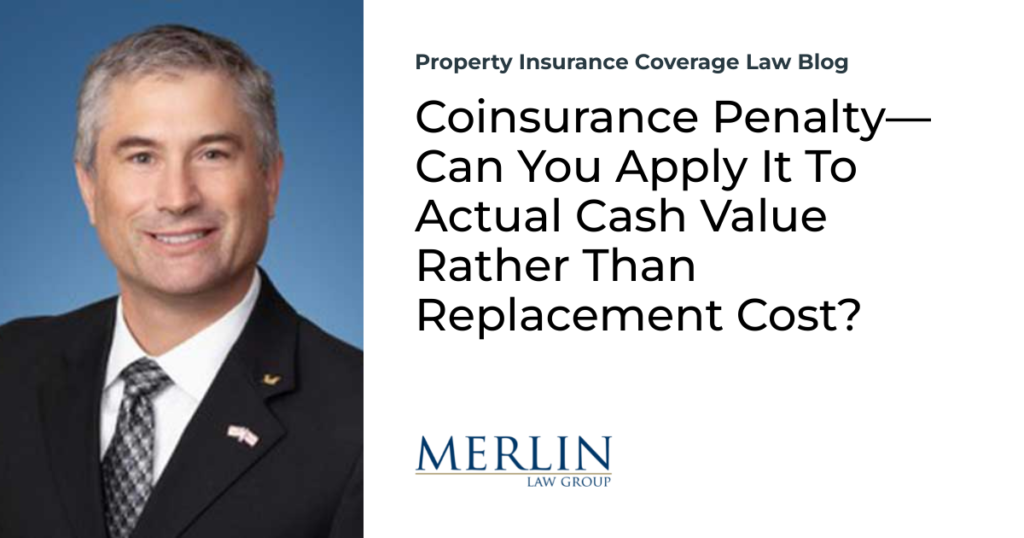Coinsurance Penalty—Can You Apply It To Actual Cash Value Rather Than Replacement Cost?

The question in the post title was recently posed to our law firm. We addressed the issue in Coinsurance Problem? Consider Filing on an Actual Cash Value Basis. Here is a summary of that highlighted case holding:
In Buddy Bean Lumber Co. v. Axis Surplus Insurance Co., the Eighth Circuit addressed whether under Arkansas law a coinsurance provision should be applied to the actual cash value or replacement cost of the covered property. The insured had purchased optional replacement cost coverage, and Axis argued that the insured’s decision to purchase such coverage ‘changed the definition of ‘value’ in the coinsurance provision from ‘actual cash value’ to ‘[r]eplacement [c]ost.’ The insured asserted that the term ‘value of Covered Property’ in the coinsurance provision ‘depends on [what] type of claim it files.’ The court agreed, concluding that ‘the proper interpretation of the coinsurance provision varied depending upon whether the insured has filed an actual cash value claim or a replacement cost claim.’ Because the insured submitted an actual cash value claim, the court held that the claim was not subject to a coinsurance penalty.1
To answer any question regarding coinsurance, one should first read the full policy (RTFP.) Policy forms vary on how the coinsurance penalty is treated. In our discussion, Merlin Law Group attorney Etienne Font made the following comment, which is something policyholders, public adjusters, and restoration contractors should consider when calculating value for coinsurance purposes:
The policy language always controls. But, if the policy states that losses will be settled at ACV. RCV being optional coverage, coinsurance could be argued should be determined based on ACV unless the claim is being made for RCV.
The insurer may argue that once you purchase RCV coverage, then coinsurance should be determined using the RCV of the Risk. But, it is generally accepted that to determine the value of the risk, one only considers items that make up the building that the policy covers and would pay for after a loss. For example, if the policy excludes foundations, the foundation costs of a risk are typically excluded in the determination of the value of the risk. I would argue similarly that if the benefits to be paid are at ACV, then the only fair value to consider is the ACV of the risk since the policy would never pay the RCV. It would be counterproductive to pay a premium on an amount the carrier would never pay.
Another item to consider is making sure you are only valuing what the policy covers in the determination of the value of the Risk. If the policy excludes law and ordinance, then the value of the risk has to be for the materials used at the time of construction, not upgraded materials the policy never intends to pay for. Similarly, if the policy excludes the antique value or preservation costs, these costs need to be excluded from the value determination.
Etienne Font also noted that a reference treatise, Property Loss Adjusting Volume 1 AIC 35by James Markham, JD, CPCU, AIC, AIAF (1990), stated the following regarding the coinsurance penalty and actual cash value:
The required amount of insurance should be based on the actual cash value of the covered property whenever actual cash value is the standard for loss settlement. This will result in the insured’s being required to carry less coverage than would be necessary to equal the replacement cost of the property. Actual cash value is usually the settlement standard for both buildings and personal property under commercial coverages. Some special commercial endorsements also have coinsurance clauses – an example of this might be various sign endorsements.
Coinsurance issues and disputes are on the rise since so many properties seem to be underinsured. The recent inflation of construction costs is part of that problem.
For those currently addressing these issues or wanting to study coinsurance more, I would suggest you read Coinsurance in Court – Who Has the Burden of Proof? and Coinsurance – A Reminder to Check if You Are Insured to Value.
Thought For The Day
In my first year as governor, we solved some of the problems that had begun to undermine the Open Records Act. We gave the Act teeth by providing criminal penalties for knowing violations.
—Roy Barnes
1 William A. Schreiner Jr., et al. Recent Developments in Property Insurance Coverage Litigation. 49 Tort Trial & Ins. Prac. L.J. 401, 413 (2013).







